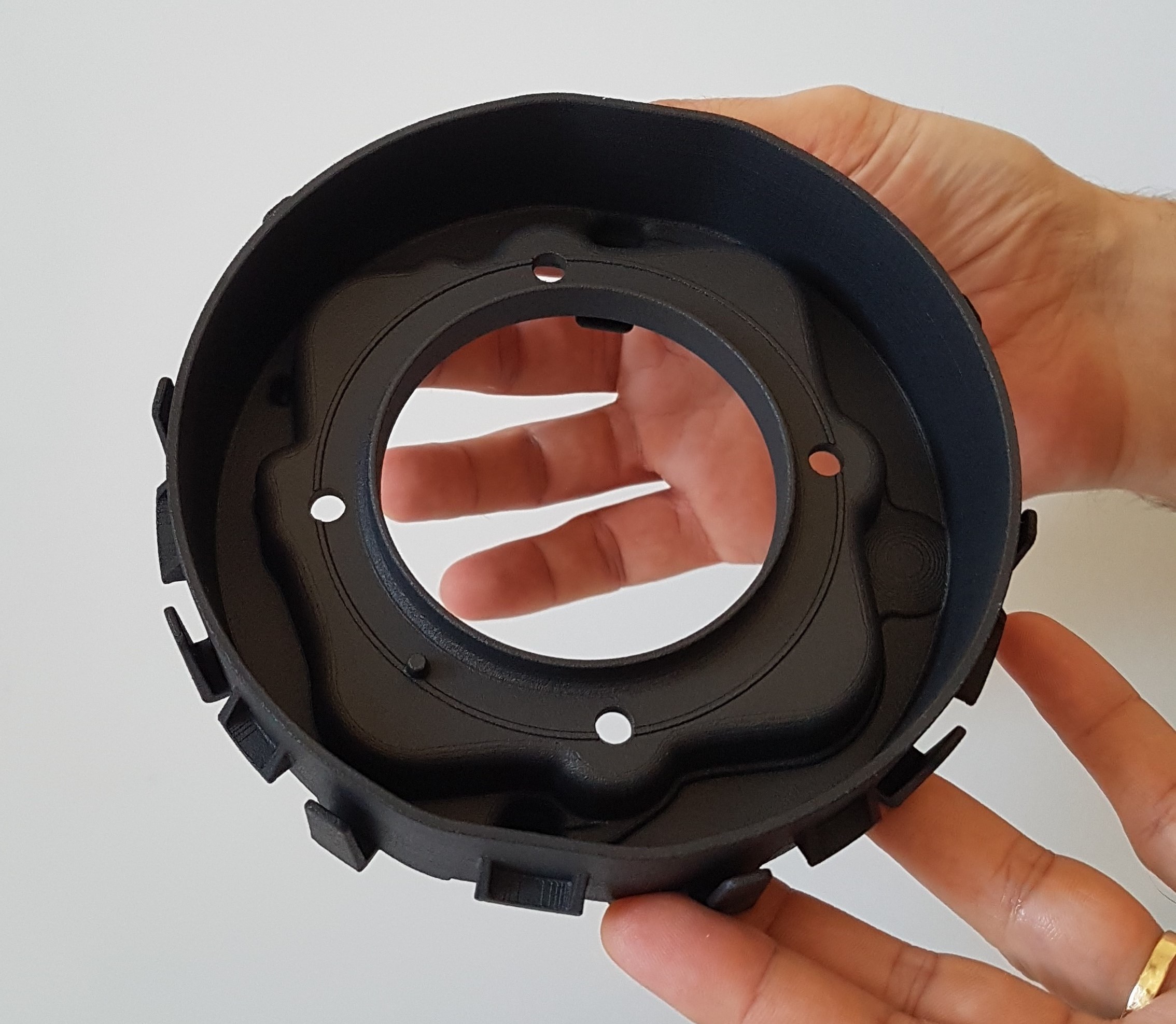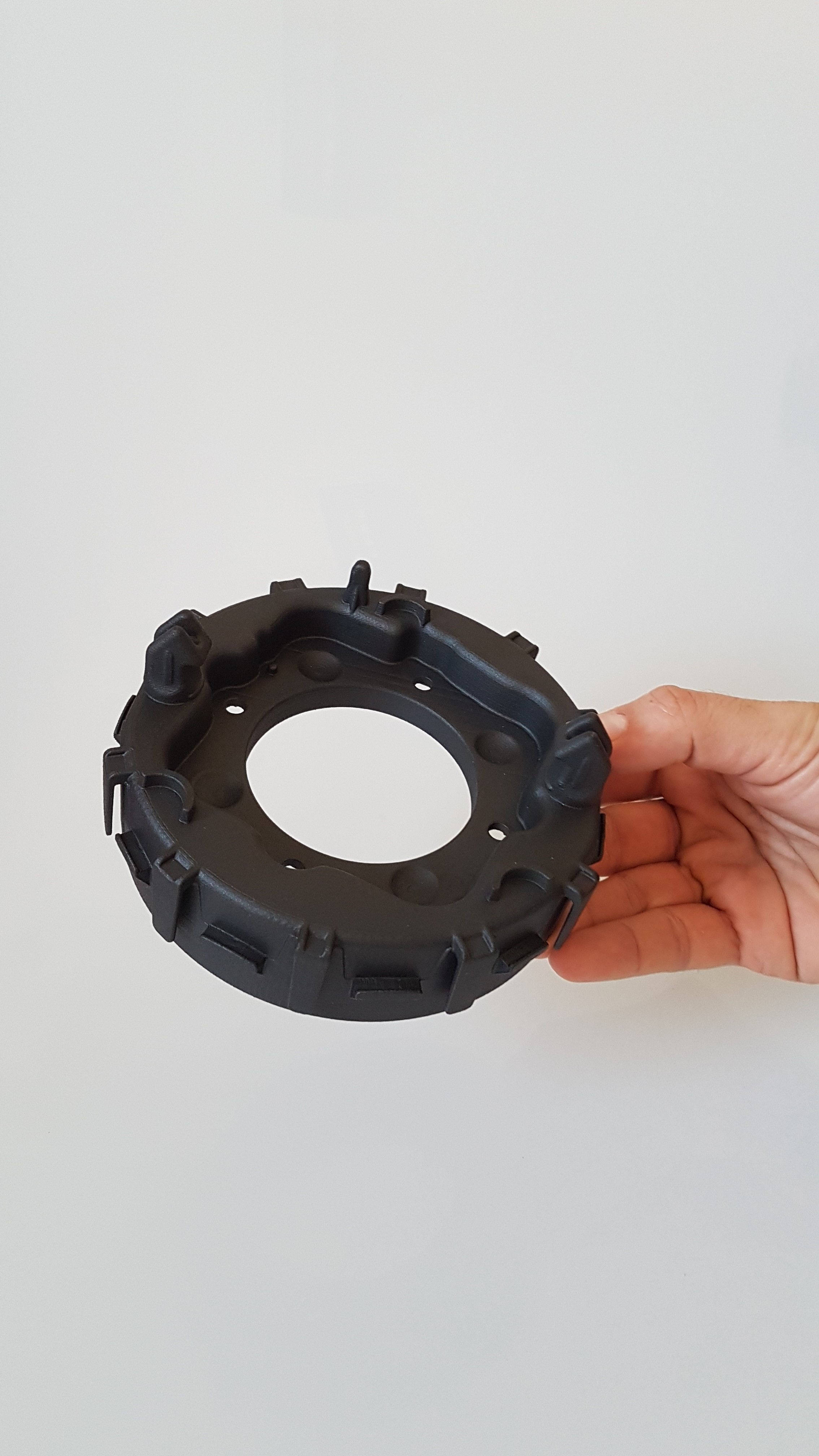Joyson Safety Systems (JSS), a Michigan-headquartered mobility safety specialist, has used SLS 3D printing with CRP Technology’s carbon reinforced composite material Windform SP to manufacture a functional airbag housing container prototype.
Looking to explore the potential of additive manufacturing in its production processes, the JSS Core innovations team sought to manufacture a functional Driver Airbag (DAB) housing part prototype in a matter of days, instead of months. It was important for JSS that the prototype was made out of composite materials which were almost similar in mechanical, thermal properties and performance to the original DAB housing materials, and thus opted to use the Windform SP carbon reinforced composite material.
“After running some market analysis in order to find out the most suitable material and process that could deliver the required performance, we came across the Windform TOP-LINE family of composite material and, specifically, the Windform SP,” comments Samer Ziadeh and Daniel Alt from JSS’ Core innovations team.
“Windform SP brought our attention to the fact that it’s a material produced from polyamide PA grades and reinforced with Carbon fiber as a powder form material, and it has almost the required and even better performance for our application.”

Producing a functional prototype in days with CRP’s 3D printing service
A global leader in mobility safety, JSS is a provider of safety-critical components, systems and technology to automotive and non-automotive markets. A subsidiary of Ningbo Joyson Electronic Corp, a Chinese automotive conglomerate, JSS manufactures safety products such as airbags, seatbelts, steering wheels and safety electronics and provides them to customers worldwide.
The JSS Core innovations team recently embarked on a project to explore the potential of 3D printing technology in establishing new manufacturing processes and the use of new materials, particularly in relation to producing DAB containers.
The team carried out market analysis to identify a composite material corresponding to the existing material used in the production of the airbag housing container, which in this case was PA6-GF40, a polyamide with 40 percent glass fiber reinforcement. The housing is usually produced via injection molding. The entire DAB system consists of an inflator, an airbag cushion, a cover and a housing with attachment points on the steering wheel.
An integral safety component of any vehicle, ensuring the performance of the DAB housing part is essential. Ziadeh and Alt explain the function of the DAB housing, commenting that “It is to withstand a high amount of dynamic loads in addition to holding the inflator and the airbag cushion fixed in location during and after the deployment of the airbag system […] The test procedures are normally conducted within a various range of temperatures between -35°C and +85°C.”
Thus, the material for manufacturing the part is expected to maintain sufficient strength, impact resistance and heat stability to perform properly under different testing conditions, with similar properties to the original material. Seeking to produce the part in a matter of days with 3D printing, the team wanted to improve upon the time-consuming and highly tooling costs of the conventional process.

The JSS Core innovations team turned to CRP Technology, an Italian 3D printing materials manufacturer, in particular seeking to leverage the company’s TOP-LINE range of high performance materials, as well as its in-house 3D printing service. Windform SP was identified as the most suitable material, a carbon fiber reinforced composite polyamide powder for SLS 3D printing. The material is suitable for applications resistance to impact, vibration, deformation, and high temperatures, particularly in automotive.
Using the Windform SP carbon composite material, JSS was able to produce a functional DAB housing prototype and to test it in a complete airbag module within a short period of time. The material reportedly exhibited excellent mechanical performance in terms of high strength and impact resistance as well as good thermal stability between a low and high range of temperatures (RT; 23°C, -35°C & 85°C).
Ziadeh and Alt add, “Also the prototype part demonstrated outstanding performance during various testing conditions, which has proven the fact of part functionality for a complete consideration of a new product development. Basically the pros by using the SLS process is the possibility to use reinforced polymers with high mechanical performance and stability.”

The CRP Windform Top-Line range of 3D printing materials
CRP Technology’s Top-Line range of Windform materials has been leveraged for numerous end-use and prototyping applications in the aerospace and automotive industry.
The Windform SP product itself has previously been used to 3D print a functional National Advisory Committee for Aeronautics (NACA) duct for the Streamliner race car vehicle. The Victory Motorsport’s Team Streamliner car went on to break a long-standing speed record at Bonneville Speed Week in 2018 – a motorsport event testing customized land vehicles.
Also included in the Top-Line range are Windform LX 2.0, Windform XT 2.0, Windform GT, which alongside WIndform SP have passed NASA’s outgassing tests.
Recently, CRP Technology expanded the Top-Line range with the addition of two flame-retardant materials – the Windform FR1 and Windform FR2. The latter has already been used by Energica Motor Company, an Italian manufacturer of electric motorcycles, to manufacture cell pouch frames for its battery pack prototypes.
The nominations for the 2020 3D Printing Industry Awards are now open. Who do you think should make the shortlists for this year’s show? Have your say now.
Subscribe to the 3D Printing Industry newsletter for the latest news in additive manufacturing. You can also stay connected by following us on Twitter and liking us on Facebook.
Looking for a career in additive manufacturing? Visit 3D Printing Jobs for a selection of roles in the industry.
Featured image shows 3D printed Driver Airbag (DAB) housing in Windform® SP manufactured via Laser Sintering process. Photo via CRP Technology


